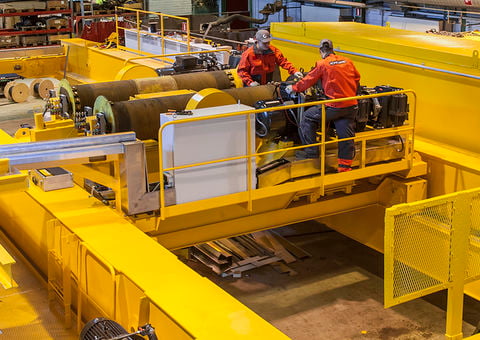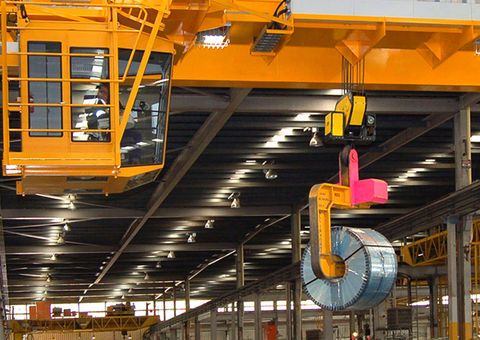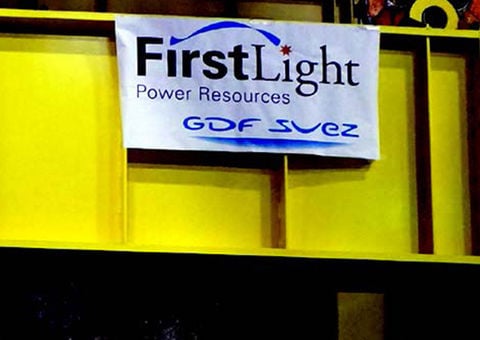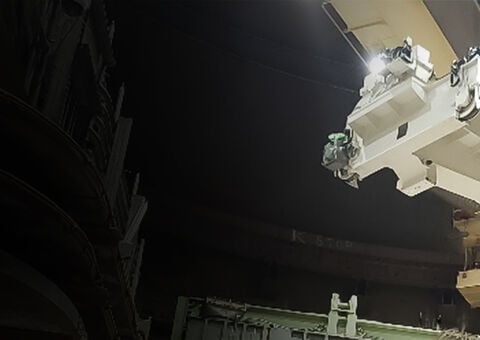Extend the service life of your overhead crane
An aged crane can be given new life. You may want to increase the speed and lifting capacity, enhance ergonomics and operator comfort, apply new safety features and positioning capabilities, or simply replace high-maintenance, obsolete components with newer technology. Whatever your need, a modernization may be a viable option to protect and extend your original investment.
Rebuild your productivity
A decision to modernize is often based on a need to achieve greater performance and throughput, and sometimes to support an entirely new process. With the right modernization, you'll end up with a fully integrated system that is tailored to the needs of your operation.
Begin with a Crane Reliability Study
A Crane Reliability Study from Konecranes provides a detailed analysis of your crane in relationship to its application. We’ll evaluate the structural integrity of the crane and the condition of mechanical and electrical components. We’ll also study load and duty requirements and maintenance records. After analyzing all these factors against the required performance needs, we will identify the most appropriate system upgrade and corresponding modernization plan.
Get the advantages of a new crane at less cost
If your needs for crane modernization extend beyond basic upgrades to improve safety, reliability and performance, we can rebuild your old crane to meet the demands of today’s high-technology standards, typically at a substantially lower cost than for a new crane.
Create a safer workplace
Technology that improves safety is developing more rapidly than ever before. Since your overhead crane was first built, safety regulations may have changed. A modernization will help you comply with current safety regulations and may reduce the risk of downtime, injuries or damage to facilities, materials or products.
Types of modernizations we offer
Based on your needs and the condition of your crane a modernization typically includes one or more of the following:
Automation and Smart Features
Automation allows for the addition of Smart Features - Konecranes-designed add-ons that work together or individually to improve safety, cycle time and load positioning. These programmed behaviors enable faster and smoother operation and help prevent issues such as overloading, snags, side-pulling and collisions.
A new automation system is designed to your needs and specifications taking into account the application and processes. Konecranes engineers provide risk analysis and then build unique automation to help improve the safety and productivity of the your operations.
Operator training for the new features is provided.
Condition/Remote Monitoring System
Adding TRUCONNECT Remote Monitoring to your crane provides real-time visibility of condition, usage and operating data from control systems and sensors on the asset as well as alerts of certain anomalies. TRUCONNECT data is accessible on the yourKONECRANES customer portal.
TRUCONNECT Remote Monitoring with alerts based on the equipment/application is required in order to effectively implement predictive maintenance. Remote Monitoring data combined with inspection and maintenance data provided by the maintenance program gives a comprehensive view of equipment maintenance needs and performance.
Crane Relocation
A Crane Relocation allows for the use of an existing crane in a new location. Konecranes experts will draw up viability and placement plans to provide options and to detail needed modifications to the crane and surroundings for a successful move.
Electrical/Control System
The cost of maintaining electrical and control systems increases over time. Components become obsolete and spare parts become unavailable. Changes in production or safety requirements may also require upgrading electrical and control systems. An Electrical/Control System modernization can help improve the reliability of your equipment and provide energy savings.
End Truck, Bogie, Wheel Assembly Modernization
End trucks, bogies and wheel assemblies are fundamental crane components built to endure great stresses and usage. Hard operating environments, runway conditions and crane usage all determine the practical usefulness of these parts. Maintenance, including replacing, adding or changing components, is key to their safety and reliability.
Hoisting Machinery Modernization
The motors, gears and wheels are the core lifting components of a hoist. When these parts wear out or become obsolete a Hoisting Machinery modernization can help maintain, or improve, the safety and productivity of your equipment.
New Lifting Device or Modification
The way a hoist lifts a load defines its usefulness. When processes change or components are nearing the end of their service life, a new lifting device or modification can make lifting safer and more efficient.
Open Winch Trolley Modernization
Open winch trolleys are made for higher load and/or duty than serial hoists. They are typically used when there is a need to lift heavy loads safely, the number of hoisting cycles is high, or physical dimensions demand special solutions.
An Open Winch Trolley modernization can help extend the lifetime of the crane and allows for the addition of the latest technology.
Operator Cab
A new or modernized operator cabin with improved ergonomics can help increase productivity. Operators benefit from an enclosed, climate-controlled space that provides maximum visibility. Konecranes console chair design offers optimum comfort and integrated crane controls. Cabin equipment is configurable allowing for future upgrades such as Konecranes cameras and monitors.
Power and/or Data Transmission
Power transmission systems feed main power to the crane, trolley and lifting device and their continuous use leads to wear. Data transmission systems are either embedded with power transmission or are separate systems. Data transmission systems become technically obsolete faster than most crane components due to the development of faster and more reliable data communication.
Runway modification
Wear and changes in work processes are two of the most common reasons to modify the runway of a crane. Over time, heavy use can lead to rail misalignment and wear. This can lead to excessive wear on the rails and crane wheels. Work demands, such as increased hoisting loads, will also tax runway structures.
Konecranes engineering can modernize runways using measurement technology such as a RailQ Runway Survey to get information on runway span, straightness, elevation and rail-to-rail elevation to help determine the correct course of action.
Safety Control System/Device
Cranes are designed to move heavy loads in an efficient manner. To operate safely cranes must be able to stop heavy loads quickly and accurately without risk of collision or loss of control of the crane and its load.
A Safety Control System/Device modernization utilizes both electrical and mechanical means. Mechanical drum brakes and storm locks stop movement. Sensors, safety PLC and collision avoidance systems are designed to help maximize safety. Means are selected based on a risk assessment and selecting applicable electrical components to fulfill the defined performance level.
Structural Modification
Structural crane modifications can be used to adapt cranes to new uses, help keep equipment in regulatory compliance or forestall costly replacements. Common modifications include reinforcing and lengthening structures.
Travelling Machinery Modernization
Changes in production and/or aging components can drive the need for replacing and/or upgrading horizontal travelling machinery. Aging components can increase the need for repairs and interrupt production. Konecranes purpose-built machineries can help improve the reliability and productivity of your equipment.
Variable Speed Control
Replacing outdated motor controls with new Konecranes Variable Speed Control (VFD) can give you better load control and performance with stepless speed control. It also allows you to take advantage of technology that is designed to address requirements for safety in lifting.
Wireless (Radio) Control System
Upgrading to a wireless control system can help improve both safety and productivity. Control pendants tether operators to their cranes. By using a wireless controller, operators can work from better vantage points away from swinging loads and trip hazards. Displays on radio or Konecranes tablet allows a remote Human Machine Interface (HMI) for the operator to see load, positions and fault information.





